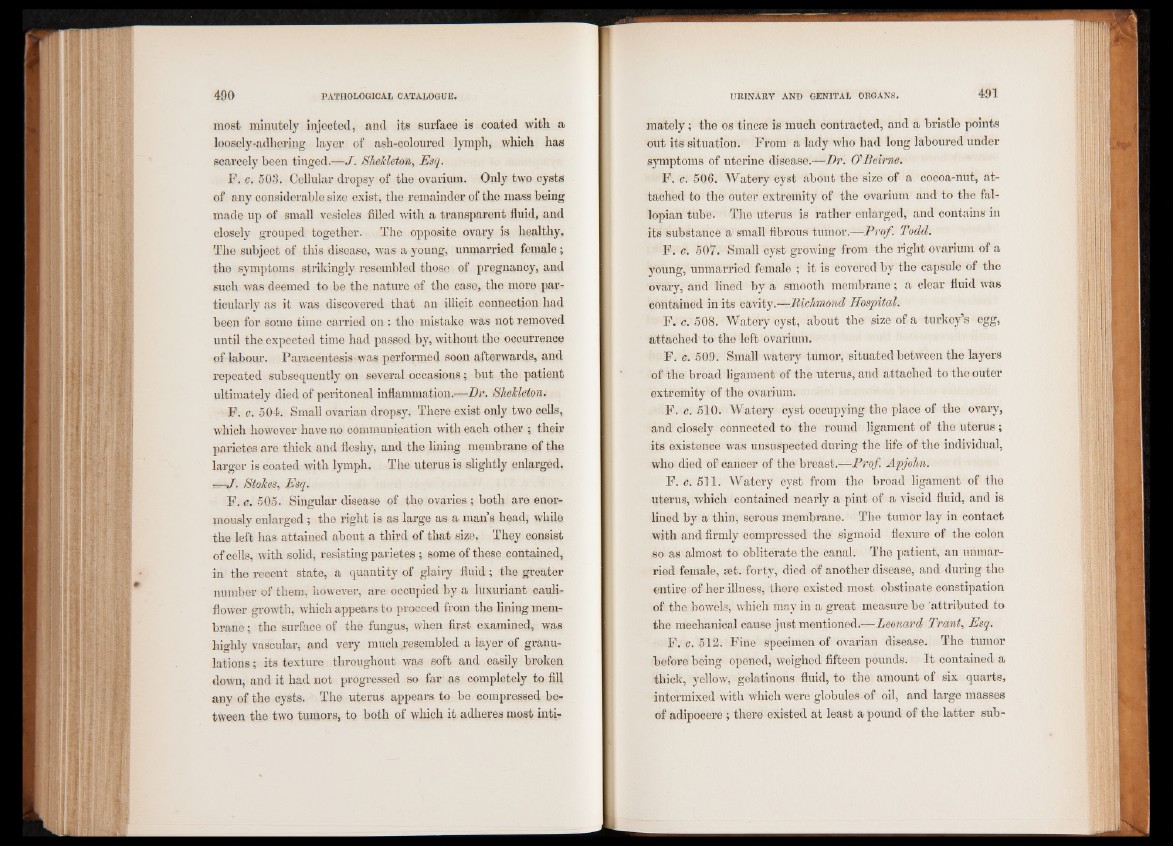
most minutely injected, and its surface is coated with a
loosely-adhering layer of ash-coloured lymph, which has
scarcely been tinged.—J. SheJcleton, Esq.
F. c. 503. Cellular dropsy of the ovarium. Only two cysts
of any considerable size exist, the remainder of the mass being
made up of small vesicles filled with a transparent fluid, and
closely grouped together. The opposite ovary is healthy.
The subject of this disease, was a young, unmarried female;
the symptoms strikingly resembled those of pregnancy, and
such was deemed to be the nature of the ease, the more particularly
as it was discovered that an illicit connection had
been for some time carried on : the mistake was not removed
until the expected time had passed by, without the occurrence
of labour. Paracentesis was performed soon afterwards, and
repeated subsequently on several occasions; but the patient
ultimately died of peritoneal inflammation—Dr. Shekleton.
F. c. 504. Small ovarian dropsy. There exist only two cells,
which however have no communication with each other ; their
parietes are thick and fleshy, and the lining membrane of the
larger is coated with lymph. The uterus is slightly enlarged.
-—J. Stokes, Esq.
F. c. 505. Singular disease of the ovaries ; both are enormously
enlarged ; the right is as large as a man’s head, while
the left has attained about a third of that size, They consist
of cells, with solid, resisting parietes ; some of these contained,
in the recent state, a quantity of glairy fluid; the greater
number of them, however, are occupied by a luxuriant cauli-
flovver growth, which appears to proceed from the lining membrane
; the surface of the fungus, when first examined, was
highly vascular, and very much resembled a layer of granulations
; its texture throughout was soft and easily broken
down, and it had not progressed so far' as completely to fill
any of the cysts. The uterus appears to be compressed be-»
tween the two tumors, to both of which it adheres most intimately;
the os tincse is much contracted, and a bristle points
out its situation. From a lady who had long laboured under
symptoms of uterine disease.—Dr. O'Beirne.
F. c. 506. Watery cyst about the size of a cocoa-nut, attached
to the outer extremity of the ovarium and to the fallopian
tube. The uterus is rather enlarged, and contains in
its substance a small fibrous tumor.—Prof. Todd.
F. o. 507. Small cyst growing from the right ovarium of a
young, unmarried female ; it is covered by the capsule of the
ovary, and lined by a smooth membrane ; a clear fluid was
contained in its cavity.—Richmond Hospital.
F. c. 508. Watery cyst, about the size of a turkey’s egg,
attached to the left ovarium.
F. c. 509. Small watery tumor, situated between the layers
of the broad ligament of the uterus, and attached to the outer
extremity of the ovarium.
F. o. 510. Watery cyst occupying the place of the ovary,
and closely connected to the round ligament of the uterus ;
its existence was unsuspected during the life of the individual,
who died of cancer of the breast.—Prof. Apjohn.
F. o. 511. Watery cyst from the broad ligament of the
uterus, which contained nearly a pint of a viscid fluid, and is
lined by a thin, serous membrane. The tumor lay in contact
with and firmly compressed the sigmoid flexure of the colon
so as almost to obliterate the canal. The patient, an unmarried
female, set. forty, died of another disease, and during the
entire of her illness, there existed most obstinate constipation
of the bowels, which may in a great measure be 'attributed to
the mechanical cause just mentioned.—Leonard Trant, Esq.
F. c. 512. Fine specimen of ovarian disease. The tumor
before being opened, weighed fifteen pounds. It contained a
thick, yellow, gelatinous fluid, to the amount of six quarts,
intermixed with which were globules of oil, and large masses
of adipocere ; there existed at least a pound of the latter sub